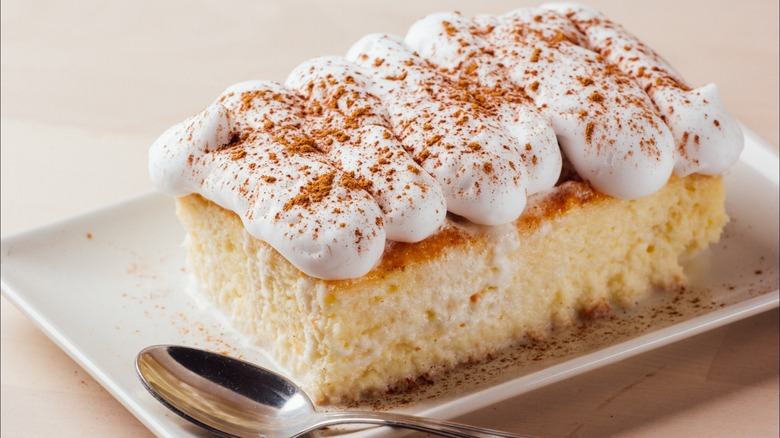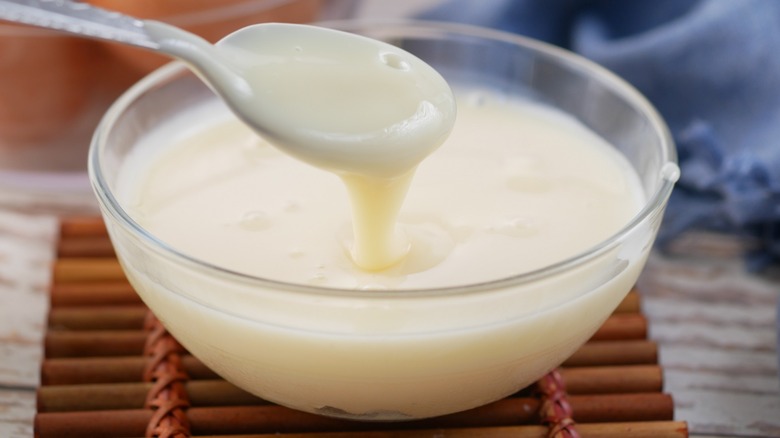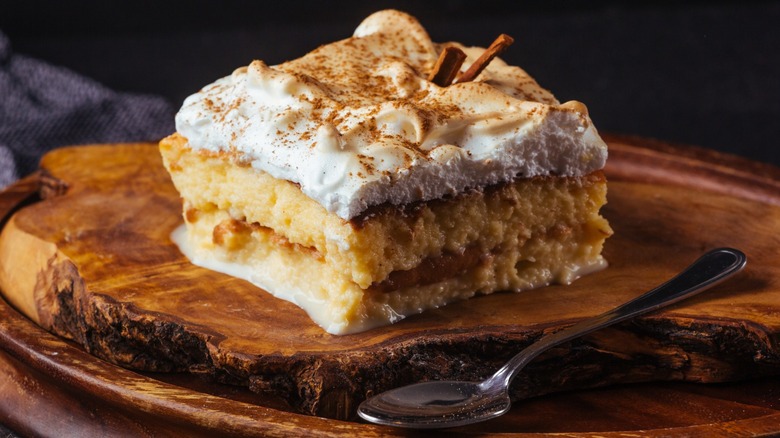What Are The 3 Milks In Tres Leches Cake?
Tres leches cake is a delicate and wonderful dessert that incorporates ingredients that are simple yet effective. Essentially a sponge cake soaked in three different milks (hence the name) and topped with whipped cream and a dusting of cinnamon, the simple elegance of the dessert means that each ingredient needs to pull its own weight. This is why the three milks you use in making the cake are of utmost importance.
A traditional tres leches cake will be soaked in a mixture of condensed milk, evaporated milk, and either heavy cream or whole milk (depending on the recipe). Each of these milks lends their own unique characteristics to the cake and makes the dish a delectable, creamy delight that remains quite light in spite of its vast dairy content. But each milk, and the dessert as a whole, is also a window into the history and creation of a dish that has become world-renowned.
The holy trinity in tres leches
The use of two canned types of milk alongside one fresh type of milk may seem like a curious choice. After all, isn't it often better to use fresh ingredients? It turns out that there's a good reason, as well as plenty of history, behind this choice. Evaporated milk is milk that has had 60% of its water removed. And although you can make your own evaporated milk at home, traditional recipes assume the use of canned milk. The same applies to condensed milk, which also has 60% of its water evaporated, but in this case, the mixture is about 60% milk and 40% added sugar. This results in a richer, more syrupy concoction. Both of these ingredients were originally made to distribute milk without worrying about refrigeration and short expiry dates. In tres leches cake, however, their fortified flavors add a concentrated creaminess to the cake, and their higher viscosity protects the cake from becoming overly soggy. Instead, the cake is saturated with the milky mixture.
When it comes to the third milk, there seems to be some debate between whole milk and heavy cream. All in all, it seems that it depends on how "heavy" you'd like your fresh ingredient to be. Whole milk is lighter at only 3.25% milk fat, and will be lighter in taste than heavy cream, which is sweeter and thicker, at 36% to 40% fat. This choice will alter the thickness and sweetness of your cake, either enhancing or lightening the creaminess and sweetness.
Tres leches: a storied but mysterious past
The exact origin of tres leches cake is still debated — Mexico and Nicaragua both claim to have invented it. Mexico claims its likely ancestor, torta de leche — a cake baked in a pan of scalded milk and possibly a successor of European soaked cakes such as the English trifle or Portugese sopa dourada.
Meanwhile, Nicaragua seems to have popularized the tres leches recipe known today, using sweetened condensed milk as both an ingredient and status symbol (condensed milk was hard to come by and therefore quite valuable in the early 1900s, when the recipe was gaining more traction). Though only conjecture, this reputation may be the reason why it's traditionally a dessert reserved for celebrations and grand events in Latin American cultures, and may be why treasured recipes for the dessert followed these same families as they moved to the United States and abroad.
The Latin American diaspora helped to spread word of tres leches further, and with a significant percentage of U.S. restaurants serving Mexican food, the iconic dessert isn't hard to find. But you can't say that its widespread availability is the only reason that it's so popular. The fact of the matter is that tres leches cake is a wonderfully-balanced yet decadent treat — neither too light nor too heavy — whose total quality is far greater than the sum of its parts. After all, there's got to be a good reason why desserts like this have been adored for so long, and why you can use tres leches to inspire other delicious desserts to this day.


